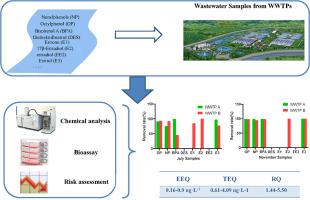Ecotoxicology and Environmental Safety ( IF 6.8 ) Pub Date : 2021-09-08 , DOI: 10.1016/j.ecoenv.2021.112758 Hairong Liang 1 , Jian Gong 2 , Kairu Zhou 3 , Langjing Deng 1 , Jiaxin Chen 1 , Lihao Guo 1 , Mengzhu Jiang 1 , Juntong Lin 1 , Huanwen Tang 1 , Xiaoshan Liu 1

|
Endocrine-disrupting chemicals (EDCs) in the effluent from wastewater treatment plants (WWTPs) are an important pollutant sources of the aquatic system. In this study, the removal efficiencies of eight typical EDCs at two domestic WWTPs in Dongguan City, China, are reported based on instrumental analysis and bioassay results. Bioactivities, including steroidogenesis-disrupting effects, estrogen receptor (ER)-binding activity, and aryl hydrocarbon receptor (AhR)-binding activity were evaluated using the H295R, MVLN, and H4IIE cell bioassays, respectively. The potential environmental risks of these residual EDCs were also evaluated. The results of instrumental analysis showed that nonylphenol was the major chemical type present among the eight tested EDCs. Meanwhile, concentrations of estrogen compounds including estrone, 17β-estradiol (E2), estriol, 17α-ethinyl estradiol, and diethylstilbestrol were relatively low. The removal rates of all eight EDCs were relatively high. Although the chemical analysis indicated high removal efficiency, the bioassay results showed that steroidogenesis-disrupting effects as well as ER-binding and AhR-binding activities remained, with E2-equivalent values of effluent samples ranging from 0.16 to 0.9 ng·L−1, and 2,3,7,8-tetrachlorodibenzo-p-dioxin-equivalent values ranging from 0.61 to 4.09 ng L−1. Principal component analysis combined with regression analysis suggests that the chemicals analyzed in this study were partly responsible for these ER and AhR activities. Ecological risk assessment of the residual EDCs showed that estrone was the most hazardous chemical among the eight EDCs tested, with a risk quotient of 1.44–5.50. Overall, this study suggests that, despite high apparent removal efficiencies of typical EDCs, their bioactivities and potential ecological risks cannot be ignored.



























 京公网安备 11010802027423号
京公网安备 11010802027423号